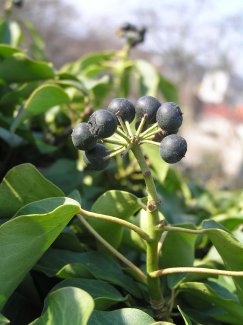Climbing perennial. Stems up to 30 m long, creeping or climbing, becoming stouter and ± erect and often arborescent at flowering; young shoots and petioles green to purplish or burgundy red, with few to numerous, (3)-6-16-(20)-rayed stellate or scale-like hairs. Leaves glabrous, dark green or variegated ivory white; leaves of non-flowering shoots broadly ovate, obtuse to acuminate, obtuse to cordate at base, usually shallowly to moderately 3-5-palmately-lobed, (1.5)-3-15-(20) cm long; leaves of flowering shoots ovate, rhombic, or elliptic, often narrower and more crowded than leaves of non-flowering shoots, acute to acuminate, obtuse at base, not lobed, up to c. 15 cm long. Inflorescence a raceme of numerous-flowered globose umbels; petals yellowish green, 3-5 mm long. Flowers deep bluish purple to black when ripe, 2-3-seeded, 5-8 mm diameter
H. helix is native to Europe, North Africa and the Near East (USDA-ARS, 2003). It was brought to North America by colonial settlers (Morisawa, 1999), but the exact date of introduction and subsequent timing and pattern of distribution within North America is unknown. During the 1900s, it was widely planted throughout the USA (Reichard, 2000; Moriarty, 2001) and it is commonly found near old and existing habitations where it often escapes; infestations are more prevalent in forest parks close to urban centres (Akerson and Gounaris, 2000). In New Zealand, H. helix was introduced as an ornamental species, being first recorded in the wild in 1873, but in the Auckland Region it is thought to have become invasive more recently, i.e. between 1940 and 1970. The species is now found throughout the North Island and parts of the South Island (Anon., n.d.). Hedera taxa including many horticultural varieties have been introduced throughout much of Europe and are known to spread (Clement and Foster, 1994). In Denmark, seeds from garden cultivars spread into natural plant communities and non-native populations have become established (Hartvig, 2002).
